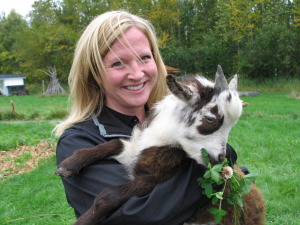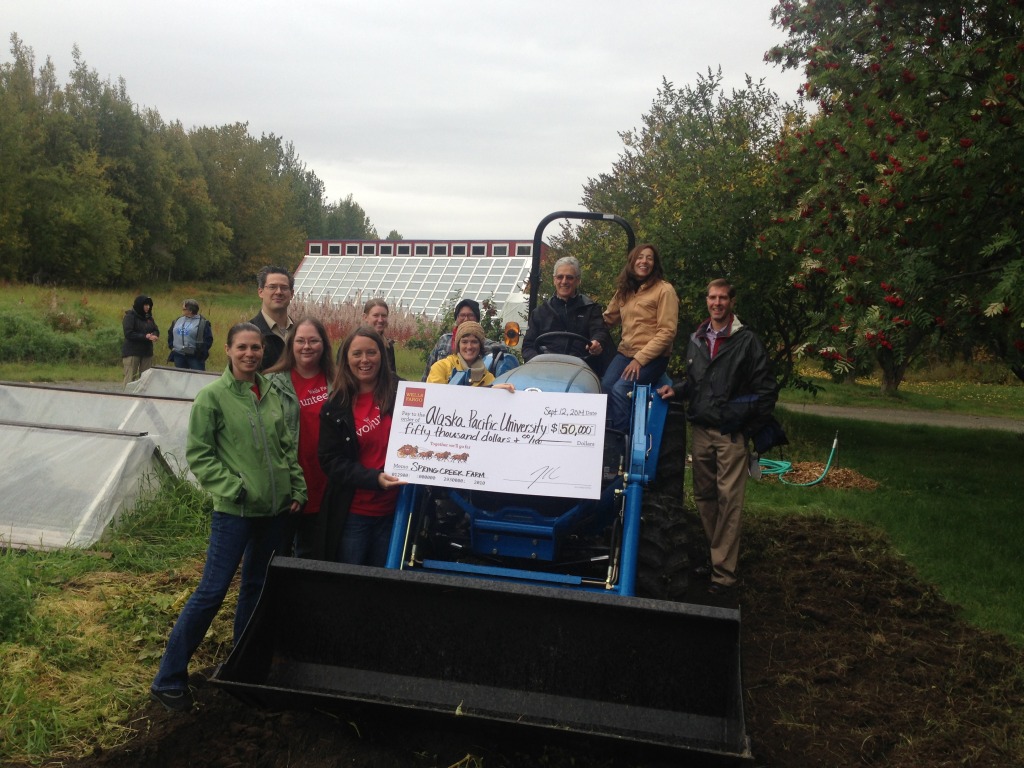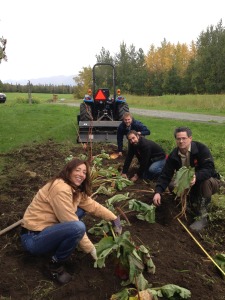Written by Lynn E. Paulson, APU staff writer
It wasn’t until I turned off the Glenn and headed west on the Palmer Wasilla Highway that I started feeling uneasy. Not five minutes before, trudging back to my car across a field through light drizzle, I had been relaxed and smiling. And why not? It was Friday, for God’s sake, and I had just spent the afternoon hanging out on the Kellogg Campus, where Wells Fargo had presented Alaska Pacific University with a $50,000 check to support an APU farming and education project, “Growing Alaska’s Farmers.”
An event that I—APU’s Communications Liaison—was supposed to be covering.
I had sent out the press release detailing the minutia of the project and the grant the week before. All I had left to do was attend the event, take a few photos and write a post for the APU blog.
Easy, right?
Only now I wasn’t so sure I had done my job. As I got closer to home, my anxiety grew, and so the very first thing I did when I got through the front door was to download the photos off my cameras and onto my laptop.
Camera One
A half a dozen or so shots of a brief ceremony under the Kellogg Pavilion. Heads cut off at the brow. The happy group emerging, ghost-like, from within deep shadows before a sign that reads “RING CREEK FAR.” Pink blurs of clapping hands. Open mouths, revealing half-masticated cookies (snacks that Joan and Don Bantz had brought to the event because I—to my shame—hadn’t thought to).
Camera Two
Thirty or more photos of Louie (a kid goat) and Lefty (a piglet), eating clover. Frolicking in their pen. Poking their little heads through the fence. From this angle. Now this one. Alone. Together. With some little kids who attend Louise’s Farm School. Wide-angle shots. Head-shots. Tight, arty shots of a goat eye with freaky, rectangular pupil.
It was worse than I thought.
I flipped through my notes. Three entries:
- Paul from WF – Alaska is doing as well as Alaska’s businesses. In the Valley, we say Alaska is doing as well as Alaska’s Farmers – (WTF?????)
- Don – G.A.F. is about growing food year round, plug it back into the school so our kids eat well. So much possibility!
- FRED’S FOR NICORETTE—DON’T FORGET!!!!!
“You’re finished,” I thought.
I don’t need to be told that being in nature is good for me, but I do need to be reminded of it often because, frankly, I haven’t been spending much time there in the last few years. When my golden retriever, Sarah Moo, was still alive, I got outside onto the trails every single day for two and three hours or more. It was a twice daily break from my work routine that I welcomed because it grounded me psychically as well as kept me in some degree of physical shape. When Sarah Moo died, I did not maintain this routine, however. I’m waaaay too busy these days doing other things, important things, job things, mostly, and chores, like laundry and vacuuming and buying cat food.
This is the lie I tell myself. The simple truth is that unless the well-being of another creature for whom I’m responsible is at stake—my dog, for example—it’s just not my inclination to seek regular time out in nature and it never has been. Given a choice between, say, spending a weekend camping in the woods or sitting for two days straight in a darkened theatre for a Kubrick or a Kurasowa retrospective or a Chuck Jones marathon, I will pick the latter every time.
It is brazen to admit this openly in Alaska, dangerous and heretical even, in this place where “city girl” is an accusation made with a snarl of contempt, where most of the people I know seem to look forward to getting outside at every possible opportunity, to pick blueberries in the fall, to ski in the winter and to hike, kayak, go camping or fishing or whatever else people do outside in the summer up here.
And I get that. I do. When I actually take the time to get outside and enjoy nature, however rarely that happens, I’m reminded all over again how it grounds and heals us by providing balance to our sedentary, indoor lives and our busy, over-stimulated minds. Freed from the constant, noisy distractions and absurd preoccupations of the modern world, we are also revealed more clearly to ourselves. It isn’t always an attractive picture.
And so it wasn’t until I arrived at the Kellogg Farm an hour early and climbed out of the car with my cameras and notebook that I slowed down enough to realize how exhausted I actually was. Standing alone in the midst of all that peace, with nothing to do but look at the fields and trees and greenhouses, I realized that I’m not only spending no time at all outdoors, I’m not taking any time whatsoever to relax and enjoy my life, and that, running from task to task to task to task like I do, I am about as grounded these days as an experimental rhesus monkey.
It wasn’t a conscious decision to spend most of my time hanging out with the pig and the goat that afternoon. It wasn’t my intention to listen to what was being said at the check presentation part of the event without writing it all down, to participate in the activities rather than just observing and taking notes. But that’s what happened.

At the APU Ground Theory Cafe the following week, I run into some of the staff from the Admissions Department. I tell Kate Miller and Makenna Wesner that I got some good shots of them at the Wells Fargo event.
“Did you have a good time?” Caitlin Poindexter asks me. She had been on the Kellogg Campus a few weeks before with some of our new undergraduate students.
“Yeah,” I say. “I had a very good time.”
“So,” she says, “did you get a million pictures of the pig and the goat?” Blushing, I admit that I did, and not much of anything else. She laughs.
“I did the same thing,” she says.


